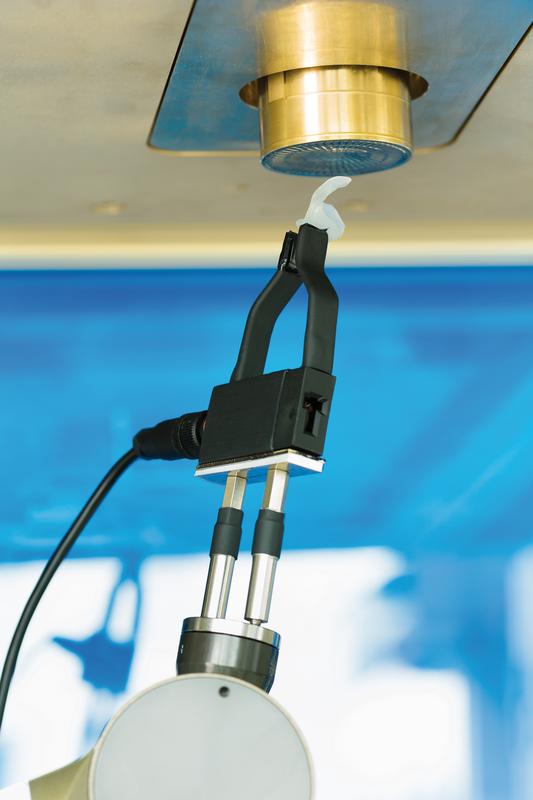Applying electron beams to 3-D objects

Electron exit window and robotic handling for applying electron beams over three dimensions © Fraunhofer FEP, Photographer: Jürgen Lösel
Electron beams are useful in many different applications. They reliably sterilize seed, can weld small structures precisely and reliable, and cure decorative paint. Usually this involves either planar, flexible, or slightly curved surfaces. However, applying electron beams homogeneously to 3-D objects of any size or shape has not been so simple up to now.
Scientists at Fraunhofer FEP have now elegantly combined an electron wand with a six-axis robotic manipulator in order to be able to treat substrates with complex shapes as well as spherical objects, for example.
“The electron wand remains stationary in this process”, explains Javier Portillo, a scientist at Fraunhofer FEP. “The manipulator rotates the objects within the irradiation zone in a way, that the surface will be treated homogeneously. This creates the maximum degree of freedom when applying an electron beam to a 3-D-object.”
Normally you need several electron-beam sources to treat 3-D objects. Homogeneous application does not take place reliably everywhere in this process. The process of multiaxial moving the object within the electron treatment zone can hereby generate advantages. The application of electron beams to optical components is also conceivable.
These primarily involve hydrophilic surfaces found in a wide variety of applications, such as safety glasses with antifogging coatings, diffusing screens and lenses, and anti-condensation coatings for air conditioners and sensors in medical engineering.
Scientists can apply the new technology to develop customized processes for its industrial clients that meet specific demands – including being able to treat 3-D objects with various geometries – to suit even the most diverse existing production lines.
The symbiosis of an electron beam and robotic handling can make production processes more effective and economical.
Among other places, the new technology will be presented by Javier Portillo at the 12th Ionizing Radiation and Polymeric (IRAP) symposium taking place on the Giens Peninsula in France from September 25 – 30, 2016.
Talk
Electron Beam Curing of Acrylic Elastomers for Medical Products
September 26, 2016, 11:30 a.m., Session XIII: Surface Treatment
Presenter: Javier Portillo
PRESS CONTACT
M.Sc. Annett Arnold | Head of Corporate Communications | Fraunhofer FEP
Winterbergstr. 28 | 01277 Dresden, Germany | Phone +49 351 2586-452 |
Fax +49 351 2586-55452 | Email Annett.Arnold@fep.fraunhofer.de
Media Contact
More Information:
http://www.fep.fraunhofer.de/All latest news from the category: Process Engineering
This special field revolves around processes for modifying material properties (milling, cooling), composition (filtration, distillation) and type (oxidation, hydration).
Valuable information is available on a broad range of technologies including material separation, laser processes, measuring techniques and robot engineering in addition to testing methods and coating and materials analysis processes.
Newest articles

Trotting robots reveal emergence of animal gait transitions
A four-legged robot trained with machine learning by EPFL researchers has learned to avoid falls by spontaneously switching between walking, trotting, and pronking – a milestone for roboticists as well…

Innovation promises to prevent power pole-top fires
Engineers in Australia have found a new way to make power-pole insulators resistant to fire and electrical sparking, promising to prevent dangerous pole-top fires and reduce blackouts. Pole-top fires pose…

Possible alternative to antibiotics produced by bacteria
Antibacterial substance from staphylococci discovered with new mechanism of action against natural competitors. Many bacteria produce substances to gain an advantage over competitors in their highly competitive natural environment. Researchers…





















